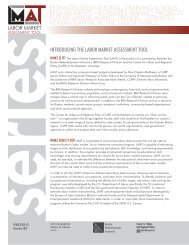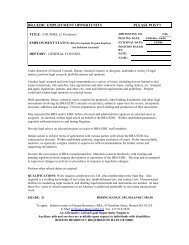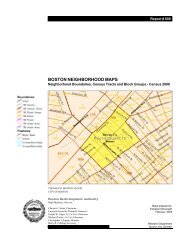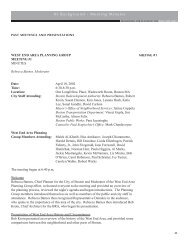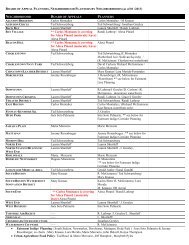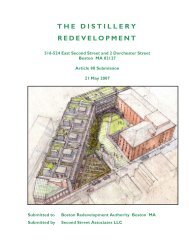Draft Project Impact Report - Boston Redevelopment Authority
Draft Project Impact Report - Boston Redevelopment Authority
Draft Project Impact Report - Boston Redevelopment Authority
You also want an ePaper? Increase the reach of your titles
YUMPU automatically turns print PDFs into web optimized ePapers that Google loves.
Exeter Residences/888 Boylston<br />
5.5 Solar Glare Analysis<br />
<br />
Introduction<br />
\\Mabos\projects\09916.00\docs\Permits\DPIR\Text\DPIR Chapter 5<br />
Environmental.docx<br />
the <strong>Project</strong> includes the addition of a 27 story building to an existing low-rise<br />
structure. The effect from the increased height of 888 Boylston from the previously<br />
approved plan is minimal. These changes will, of necessity, require a change in the<br />
view of the site and sky plane when viewed from the adjacent public streets and<br />
sidewalks.<br />
This section includes an assessment of the potential solar glare impacts from new<br />
program and mitigation strategies, if necessary, to offset potential heat gain and glare<br />
impacts. Although the Prudential Center <strong>Redevelopment</strong> FPIR/FEIR did not include<br />
a solar glare analysis, the discussion presented in the NPC/PNF and this DPIR<br />
demonstrates conformance with the Article 80 Review guidelines and responds to<br />
agency comments generated from the NPC/PNF filing.<br />
The Exeter Residences building is a predominantly masonry building with<br />
residential scale fenestration that is expected to have a limited solar glare and heat<br />
gain effect on the surrounding buildings. The masonry shaft will have cantilevered<br />
glass bays that rise up the entirety of the north façade.<br />
888 Boylston is proposed to be a fully glazed building set back 92-feet from the<br />
Boylston Street curb (77-feet from the property line), and buffered from the street by<br />
street trees and plaza plantings. As a fully glazed building, there is a potential for<br />
glare and heat gain effects on neighboring streets and buildings as discussed below.<br />
There are two general types of solar glare and they are commonly referred to as<br />
“spot glare” and “scattered glare.” The first originates as a reflection from smooth<br />
façade buildings which creates a glare with an equal level of intensity as the source<br />
object. The second originates as porous surfaced buildings diffuse the light as it’s<br />
reflected thereby decreasing the intensity of the glare and making it appear scattered.<br />
Reduced intensity alleviates squinting and general discomfort for pedestrians and<br />
drivers.<br />
Since the normal human viewing range is commonly defined as an angle 30 degrees<br />
above to 45 degrees below the horizontal, and 65 degrees to the left or right of the<br />
forward line of sight, solar glare angles located outside of these parameters have little<br />
to no effect. In addition, glare angles that run perpendicular to the observer (e.g.<br />
pedestrian, automobile driver) have no adverse impacts. In some cases lower solar<br />
altitude angles produce glare (distant glare) within the discussed viewing range,<br />
however the solar intensity is decreased due to the greater expanse of atmosphere<br />
DRAFT - Environmental Protection 5-32




